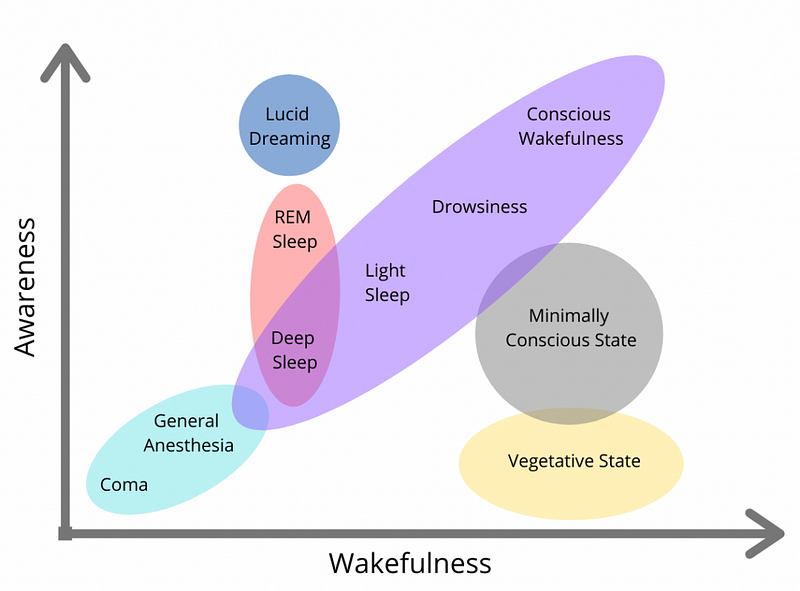Exploring Consciousness: The Neuroscience Behind Awareness
Written on
Chapter 1: The Evolution of Consciousness Study
Historically, consciousness was primarily a philosophical topic, often deemed too abstract for scientific inquiry due to its non-physical characteristics. However, the past few decades have witnessed a significant shift as neuroscience has begun to tackle this complex phenomenon.
The dialogue surrounding consciousness has transitioned from a mystical concept to one that is increasingly linked with the physical brain. While some interpretations still retain spiritual elements, many discussions are now grounded in scientific methods. We now have experimental techniques to quantify consciousness, which I will explore further in this article.
Before diving into these techniques, it’s essential to define what consciousness is and how neuroscience approaches it.
What Is Consciousness?
In scientific contexts, precision in definitions is crucial. Without a clear definition, it becomes challenging to identify and measure consciousness, leading to flawed experiments and misinterpretations.
Consciousness is notoriously difficult to encapsulate, with numerous philosophical debates presenting various definitions. For practical purposes, a widely accepted understanding is that consciousness refers to an individual's awareness or experience of the surrounding world.
This definition assumes that consciousness arises from brain activity; without this premise, there would be little reason to investigate it from a neuroscientific standpoint. Although this definition may not cover all aspects of consciousness, it provides a useful starting point for our research.
Altering Consciousness: Different States
To measure consciousness effectively, we must examine instances where it changes. Are there altered states of consciousness, and if so, what are they? Identifying these states allows us to analyze how the brain behaves differently in each condition.
One such state is deep sleep, experienced nightly by most of us. In this phase, awareness is significantly diminished, leading to a limited grasp of the external environment. When comparing brain activity during deep sleep to that of full wakefulness, notable differences emerge.
For example, during wakefulness, brain activity is characterized by beta waves (over 13 hertz), while deep sleep is associated with delta waves (1-4 hertz). In REM sleep, the brain's pons activate, preventing physical movement to avoid acting out dreams. Such differences are vital for understanding the brain's role in consciousness.
Another intriguing yet unsettling altered state is locked-in syndrome, where individuals are fully aware but unable to move except for limited eye movements. Understanding these cases is critical for accurate assessments of consciousness, preventing misdiagnoses like brain death and ensuring appropriate care.
When comparing various states, we typically evaluate them along two axes: awareness and wakefulness. Awareness pertains to the content of our consciousness, while wakefulness relates to its level—higher wakefulness means greater consciousness of multiple stimuli.

How Do We Measure Consciousness?
Having established a definition and identified various states, we can now explore the methodologies for measuring consciousness. Three primary approaches exist: neural correlates, behavioral responses, and self-reported experiences.
The first approach, neural correlates, involves assessing neuronal activity in relation to awareness. Advanced technologies, such as EEG (electroencephalogram) and transcranial magnetic stimulation, allow us to investigate how brain activity correlates with consciousness. For instance, these methods can reveal that individuals in certain comatose states may still perceive their environment despite their lack of response.
The second method focuses on behavioral correlates. This involves examining responses to stimuli, such as pain, to gauge consciousness levels. This is particularly significant for conditions like unresponsive wakefulness syndrome, where individuals appear awake but cannot respond meaningfully.
The third method is subjective and relies on individuals’ self-reports of their experiences. While this approach has limitations—such as the challenge of recalling experiences—it still provides valuable insights into consciousness levels.
Through these methodologies, researchers can uncover various consciousness disorders, including minimally conscious states, unresponsive wakefulness syndrome, locked-in syndrome, and sleepwalking. Studying consciousness in controlled settings enhances our comprehension of these phenomena.
Final Thoughts
As a relatively new area within neuroscience, the study of consciousness is rapidly evolving. My fascination with this subject drives my interest in pursuing further research in the field.
Current neuroscience aims to address what is known as the "easy problem" of consciousness: identifying the brain regions responsible for consciousness. However, a more challenging question remains: why do these brain regions correlate with conscious experience? After all, it’s conceivable that they could function without producing consciousness, suggesting it may merely be a byproduct of brain activity.
To deepen your understanding of consciousness, consider exploring related content, such as my podcast, "Philosophy Over Tea," which delves into consciousness and more!
Chapter 2: Video Insights on Consciousness
In this section, we will explore two YouTube videos that further elaborate on the topic of consciousness.
The first video, Becoming Conscious: The Science of Mindfulness, discusses the scientific basis of mindfulness and its implications for understanding consciousness.
The second video, Could AI Ever Become Conscious?, poses intriguing questions about the possibility of artificial intelligence achieving consciousness, prompting discussions about the nature of awareness.